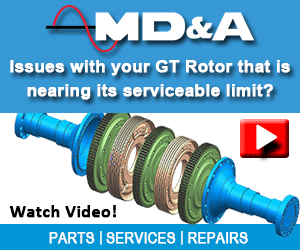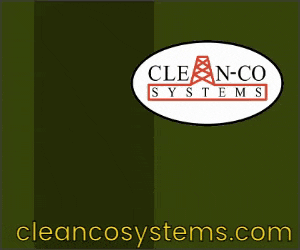After reading the high-level summaries of the vendor presentations from the 2023 7FUG presented here, go to www.powerusers.org and look at the slides, available for viewing to user members of Power Users (user non-members will have to apply and be approved by the leadership). If you are responsible for 7Fs in your fleet, the editors believe you’ll be glad you did. Access an overview of the end user presentation and discussion topics here.
Gas turbines
Gen 2 combustor-cap effusion plate design is said to have a service life of 48,000 hours and 1800 starts (Fig 1). It takes advantage of the vendor’s stated unparalleled repair experience with liners, transition pieces, and caps over 18 years. Expansive design details include new materials, new cooling-hole dimensions, more closely spaced outer-diameter holes, changes to lip height, and others. Slides offer a thorough review of OEM and Gen 1 designs and operating history. Presenter challenges the notion that the OEM’s Technical Information Letter (TIL) recommendation to include a thermal barrier coating (TBC) to the part will always solve problems.
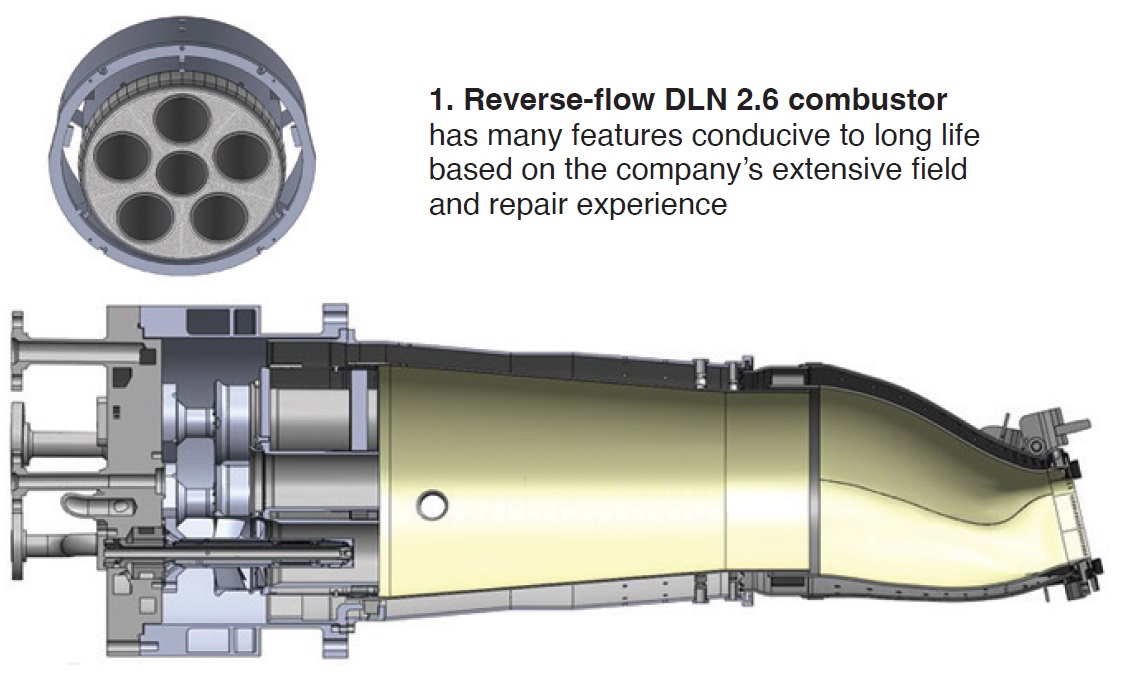
Design and Development of a DLN 2.6 Combustor Cap Effusion Plate, Aaron Frost, APG
Flow testing of transition pieces, an “uncommon practice” in the industry, has been implemented at vendor’s shop for combustion-system optimization. It can help address exhaust-temperature-spread issues, ease combustor tuning, and assist in troubleshooting. Photos of sonic and vacuum flow testing equipment are included, along with diagrams and descriptions of combustion system components.
Combustion System Optimization, Jim Neurohr, Sulzer Turbo Services Inc
Single-crystal components are “fully repairable,” with attendant performance improvements, and has been demonstrated through company’s experience, beginning with an EPRI demonstration project. Case studies review first-stage-blade tip restoration and coating, and first-, second-, and third-stage nozzle repairs.
Gas Turbine Parts Repairs and Solutions, Jose Quinones, MD&A
Upgraded 1-2 spacers featuring 11% cyclic stress reduction are just one of several component replacement and repair options as a result of company’s reverse engineering, production, and repair development programs. There are “replacement options for all problematic components,” and repairs to correct disc issues, compressor dovetail cracking, first-stage-disc balance weight and groove cracking, first- and second-stage-disc cooling-slot cracking, 1-2 spacer rim cracking, and second-stage-disc lockwire-slot cracking, among others.
7FA Rotor Life Assessment with 1-2 Spacer Cracking Evaluation, Mark Passino, MD&A
Failure analysis can be a “strong learning opportunity,” says the presenter of this tutorial, which is based on a chapter from a one-day course offered by the vendor. Collecting O&M data and history, conducting root-cause analysis, elements of expert witness activities, writing good reports, and metallurgical analysis and NDE techniques are all explored (Fig 2). Conclusion? An expert at failure analysis is a “bad-ass miracle worker.”
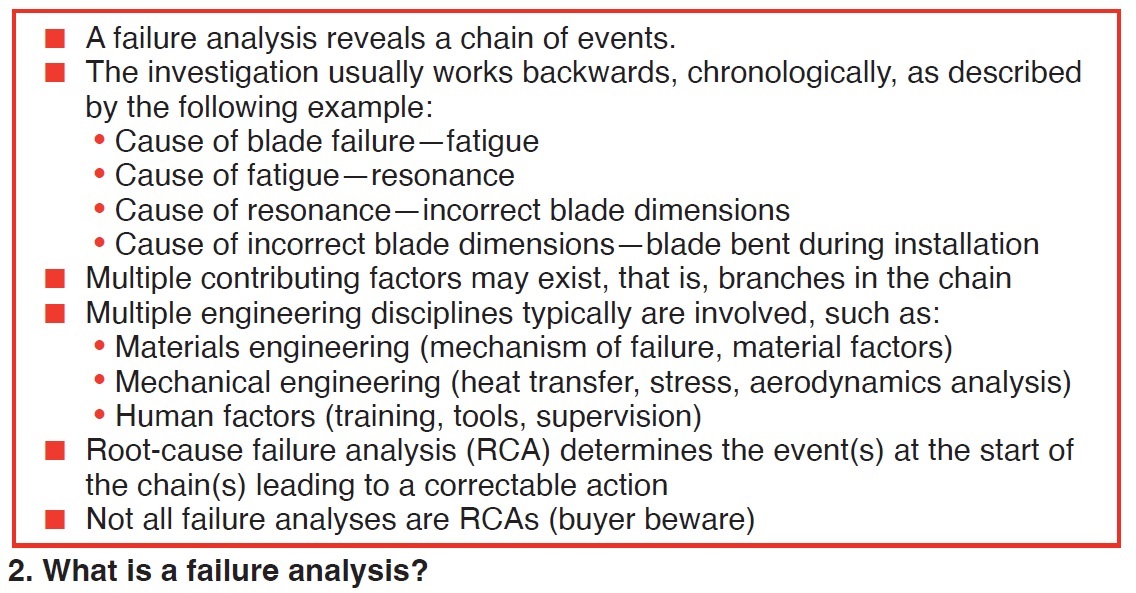
GT Failure Analysis, Doug Nagy, Liburdi Turbine Services Inc
Exhaust noise at a simple-cycle GT site is addressed in a case study including problem definition, site engineering (noise study, vibration testing, and thermography), modeling, engineering solution, and evaluation of performance, which proved to be better than predicted. The 9 × 9 bar silencer array and modified turning-vane set subsequently installed also reduced total pressure loss by 0.5 in. H₂O.
Dynamic Case Studies on Turbine Exhaust Systems—Gas Path Upgrades, Scott Schreeg, SVI Industrial
Managing end-of-life (EOL) rotor issues requires at least a two-year planning cycle, maybe three, if you have one of the 400 7F units installed between 2000 and 2004. Reason: A hundred of those rotors will need major service or replacement over the next few years. Presenter covered many life evaluations, upgrade packages, and replacement options—including complete flared and unflared offerings—as the industry struggles to handle the volume of 7F EOL needs.
Managing the 7F Rotor Wave with Ingenuity, Brian Loucks and Katie Koch, PSM, a Hanwha company
Hypothetical nighttime emergency trip at full speed/full load is imagined to illustrate how company can work with a customer after the borescope inspection reveals heavy compressor damage. Simulated failure situation steps through mobilization of field service crew, preservation of evidence, on- and offsite activities, in-shop rotor evaluation, client reports, repairs/coatings, replacement parts and manufacturing, rotor balancing, root cause analysis, materials evaluation of failed components, and rotors and components successfully returned to site and put in service.
A Bump in the Night, Jim Neurohr, Sulzer Turbo Services Inc
Options for extending unit turndown to remain relevant during the market transition from fossil fuels to non-carbon energy sources are explained. Options are anchored by the vendor’s Ecomax® software, including the integration of inlet-guide-vane (IGV) angles with an inlet-bleed-heat (IBH) engineering upgrade. Interestingly, investment attitudes, based on a popular annual survey of executives, around solar, wind, and storage dropped significantly between 2021 and 2022, while natural gas grew three percentage points.
Turndown or Shutdown? Combatting the Effects of Increased CCGT Cycling, Jeff Schleis, EthosEnergy Group
Fleet issues with exhaust frames are described and enumerated, along with company’s upgrades for the flex-seal retention assembly, L seal monoblock, parting joint, and airfoil and insulation packages. Replace, refurbish, and repair decision methodologies are illustrated with several case studies.
7F Exhaust Frame R3 Modifications and Upgrades: 2023 Update, David Clarida, Integrity Power Solutions
Upgraded or repaired liner plates in transition ductwork between the turbine exhaust and HRSG can be provided along with exterior (for example, thermography) online, and interior offline, inspections to identify problems and failure areas. Also discussed are services around compliance with the ASME Power Piping Code for high-energy and covered piping systems. Expansion joints, HRSG pipe penetration seals, and HRSG inspection and performance analysis complement vendor’s portfolio of services.
7F Transition Duct Liner Plate & HRSG High Energy Piping Programs, Ryan Sachetti, IAFD
Water-repellent air intake filters made of synthetic materials are now available from company which has been exclusively supplying one major GT vendor since 2019 and now has special agreement for the US market beginning 2023. Data from case study of an F-class unit in a coastal wet/foggy northern European plant supports claims of better performance. Other company capabilities: acoustics, wet compression, evaporative coolers, chillers, and anti-icing systems.
New ISO 29461-2 for Gas Turbine Air Inlet Filters, Gianluca de Arcangelis, NRG-Faist
HRSGs
Fouling of HRSG tubes, contributing to higher turbine exhaust backpressure adds risk for machine trips and runback during cold-weather operation, which has been under the regulatory microscope in recent years. Actions for preventing gas-side fouling are presented, with a caution not to ignore baffles, relatively inexpensive and often overlooked. Expert examines six topics which, when addressed together, can restore up to six megawatts of output.
Improving HRSG Efficiency with Operational and Design Modifications, Cesar Moreno, HRST Inc
HRSG tube-plugging options are worthy of consideration because “tube leaks happen” and often it is necessary to get the unit back online quickly (Fig 3). Generally, though, you should strive to fix the leak and seek to identify and address the cause. Slides run through the typical causes of tube leaks with plenty of detail on four tube plugging options, attention to ASME Boiler & Pressure Vessel and National Board Inspection Codes; and pros and cons of plugging. Always insist on a documented repair plan before beginning a plugging project and be sure to stock tubes and plug materials.
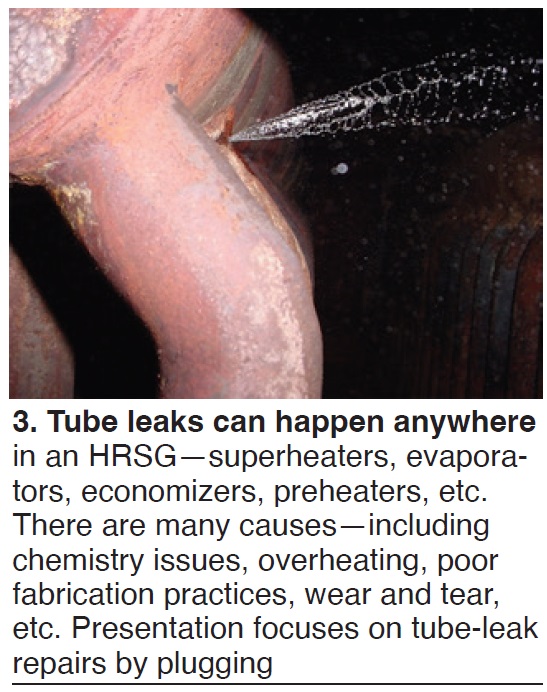
HRSG Tube Plugging Strategies to Simplify Tube Leak Repairs in Aging F-Class Units, Lester Stanley and Rich Miller, HRST Inc
Steam turbines
Warming your steam turbine and HRSG between shutdown and startup addresses fatigue issues, emissions and fuel consumption, and performance losses. A D11 case study reveals impressive results, such as combined-cycle start times improving from 266 to 149 min (Fig 4), and reduction of high-pressure-rotor life consumption by 25%. Photos and explanation of sophisticated insulation and electric warming systems for ST/Gs are provided. A beta site is being sought for a new HRSG warming system developed with EPRI. Vendor has added onsite machining services for steam valves.
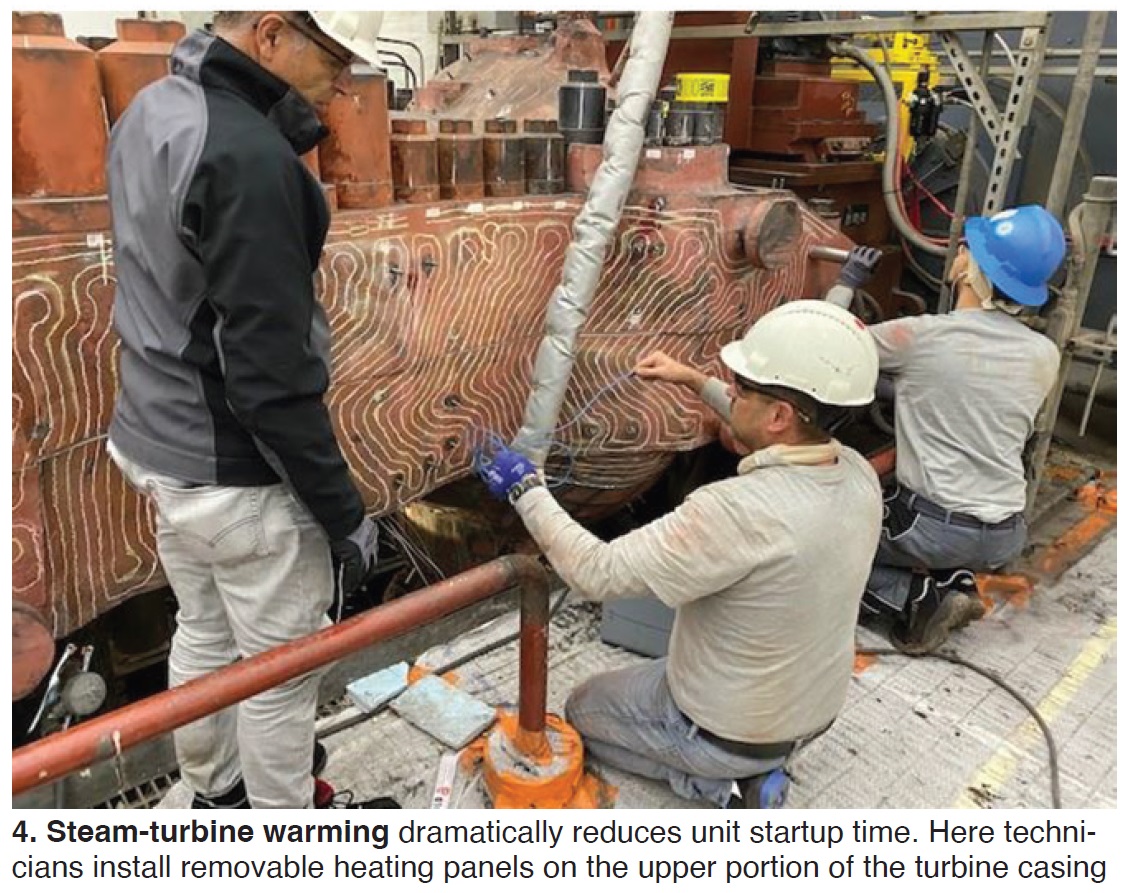
Complete Cycle Solution for Optimized CCGT Startup, Pierre Ansmann, Arnold Group
Generators
Emergency purge of generator H₂ coolant can avoid catastrophic loss during fires, seal-oil issues, H₂ piping failures, and severe weather events. A photo montage of explosions reveals how serious such loss can be. Fast-purge package, including the fast degas CO₂ skid and gas monitoring and control piping, allows all purge operations to be managed from the control room via DCS or locally on HMI. System also can reduce purge times to less less than one hour.
Benefits of the Generator Fast-Purge Package on a GE7FH2 Generator, Rob Kallgren, Lectrodryer
Generator collector performance depends on consistent and adequate brush film, adequate contact pressure, proper ring surface conditions, and continuous brush-to-ring contact. Daily/weekly monitoring with minor maintenance is key. A plethora of photos document and illustrate common problems and solutions such as footprinting (also called ghosting, photographing), brush restrictions, brush-holder spacing and alignment, contamination, wear patterns and mechanisms, repair indications, collector-ring resurfacing, and vibration.
Generator Collector Performance and Maintenance, Jamie Clark, AGT Services
Complete stator replacement is reviewed as a veritable photographic journey for a unit which, in October 2020, experienced core looseness at the turbine end and broken off core laminations (Fig 5). Site involved has two 2 × 1 blocks with dual-fuel 7FA gas turbines, one block with a D11 steamer (commissioned in 2011) and the other with an Alstom turbine/generator (commissioned in 2006).
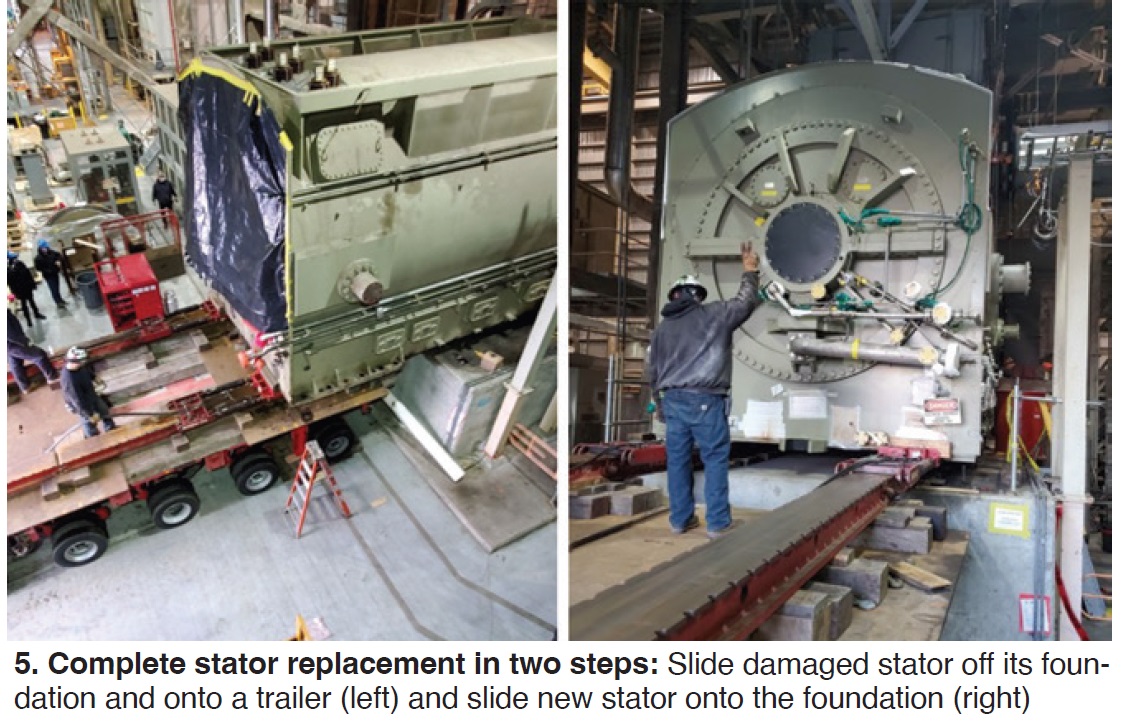
7FH2 Stator Replacement, Shawn Downey, MD&A
General, BOP
Incorrect tightening of bolts can lead to catastrophic failure, and bolt stretch is a key factor in proper bolt tightening, because stretch is directly proportional to the tensioning force applied. A detailed list of tips for proper tightening is included in Fig 6.
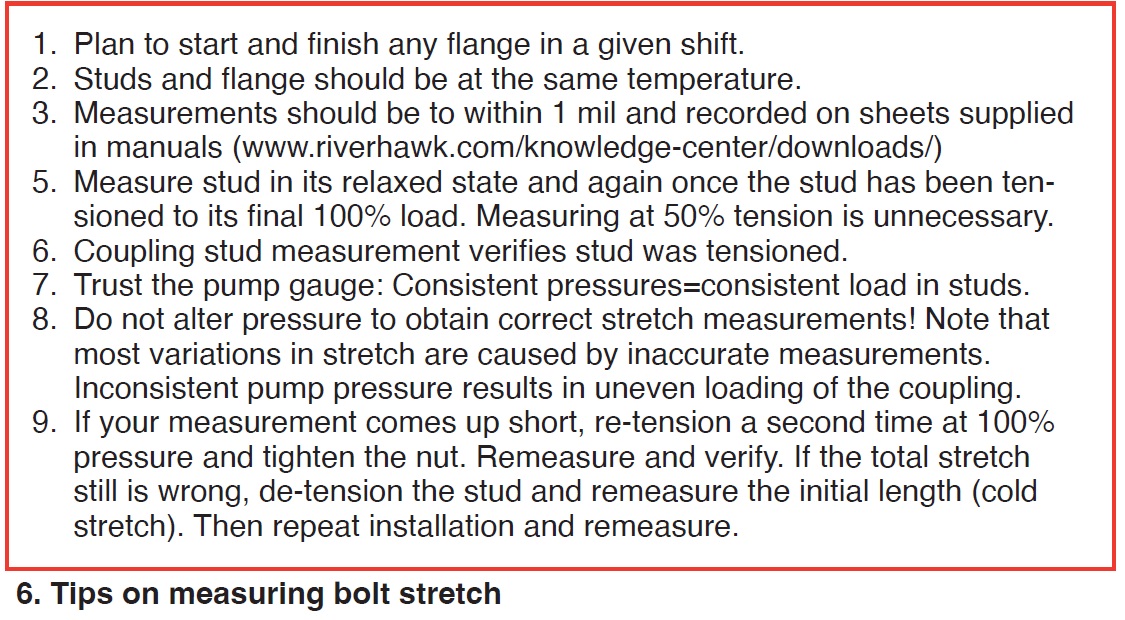
Coupling-Stud Stretch Measurement Can Make or Break Turnaround Time, Dan Johnston, Riverhawk
Polyalkylene glycol (PAG)-based electrohydraulic control (EHC) fluids are compared to several different phosphate ester formulations, with pros and cons delineated for each. After 10 years of use at one site, vendor’s PAG-based EcoSafe EHC S3 DU showed an impressive total acid number, a key performance index. One powerplant with three steam turbine/generators running on the same charge of this fluid reported “no issues with system pumps, servos, or actuators, no detrimental effects on fluid from temperature excursions, and fewer issues with moisture contamination.”
PAG-based EHC Fluid, a Sustainable Alternative to Phosphate Ester for EHC Application, Chris Knapp, Shell Lubricant Solutions
The Mobil™ turbine-oil triage chart can be applied for mitigating varnish, says presenter, after you’ve assessed the situation you are trying to address (extend outage intervals, correct operational issues, support future conversions) and gathered basic information and conducted a root-cause analysis. Impact photos from the use of several different Mobil products and services are included.
Mobil™ Turbine Oil Triage Guide, Chandler Rogers, Mobil
Third-generation dual-fuel water-injection system components (Fig 7) are said to have performed very well at the customer site referenced: liquid-fuel starts and transfers exceed the “industry standard success rate,” purge-air check valve operates with no leakage, check valves and three-way purge valve experienced no failures over multiple years, and water-injection flow proportioning valve operated multiple years without failures, despite thousands of hours of downtime.
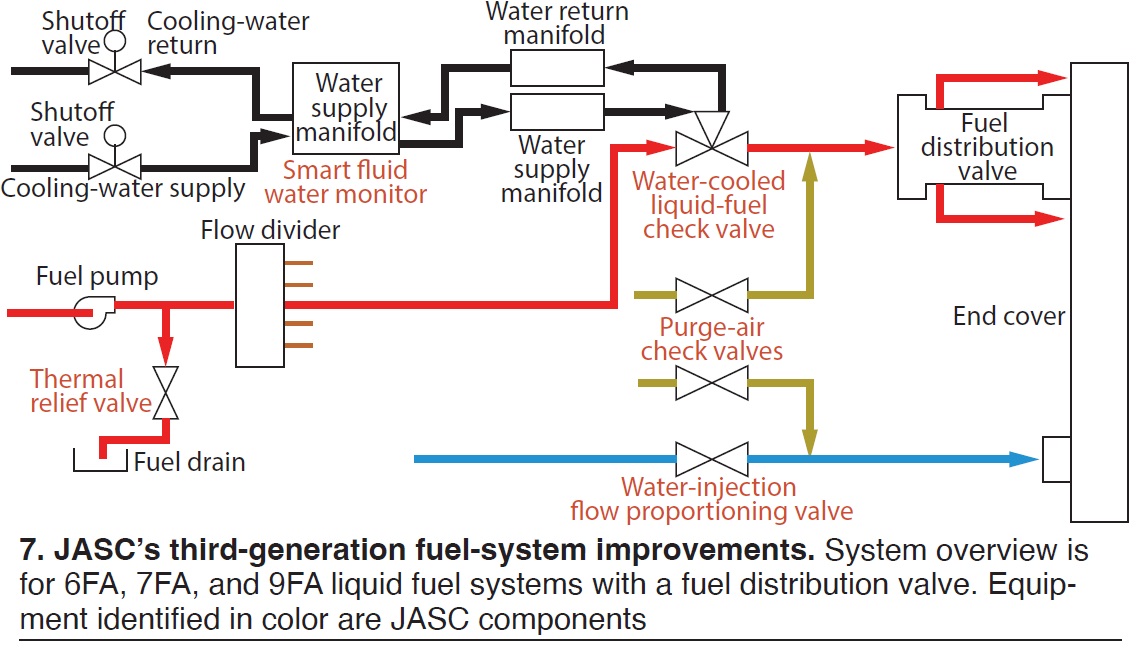
20 Years of Reliability: A System-Based Case Study, Dual Fuel with Water Injection, Schuyler McElrath, JASC
Comprehensive weather readiness assessment can help ensure that your site complies with latest regulatory mandates that plants provide maximum and minimum ambient dry-bulb temperatures to which units can operate without a forced outage, derate, or failure to start. Checklists for turbine/generators; fuel supply, plant air, lube oil, cooling, and water systems; and cabinets and compartments are included.
Extreme Temperature Readiness, Jason Neville, TG Advisors
Expanding sleeve bolt technology can avoid problems like seized fitted bolts and studs, which often have to be destroyed to be removed and can lead to damage to the coupling holes themselves, extending downtime. Vendor’s EZFit technology can be considered a permanent replacement for other prevalent designs.
Turbine/Generator Coupling-Bolt Solutions, Peter Miranda, The Nord-Lock Group/Superbolt
Tutorial on the use of hydrogen as a fuel includes H₂ properties, sources, value-chain considerations, percentage in blends, industry experience, and challenges to adoption.
H₂ as a Fuel for GTs in the Power Industry, Gus Graham, CRDX Carbon Reduction Systems
High-pressure water-mist systems for fire suppression are explained, then compared to other options such as CO₂, Halon, dry chemical, inert gas, and low-pressure water mist. Three HP water-mist delivery-system designs (skids, fluid containers, piping) are illustrated. Meeting water quality recommendations is a must when using these systems, and design should meet the NFPA definition of water mist—99% of droplets at minimum operating pressure are less than 1 mm in diameter (layman’s version).
Water Mist Fire Suppression for Power Generation, Dale Shirley, Marioff NA
Controls
Findings and observations from the perspective of an owner’s engineer during the upgrade of two gas turbines from a Mark VI/EX2100/LS2100 to a Mark VIe/EX2100e/LS2100e control system are presented.
Control Solutions, Abel Rochwarger, GTC Control Solutions, a division of AP4 Group
The impact of instrument-related events on machine reliability opens this slide set, with statistics worth contemplating—for example, upgrades and maintenance would have prevented 40% of the reported failure events. Balance of preso reviews reliability assessments for exciters and load commutated inverters (LCI), component replacement intervals, maintenance and testing of on-shelf electronics, TILs associated with these components, and performance evaluation.
Exciter and LCI Controls Reliability for 7FA Gas Turbines, John Downing, TC&E, a division of AP4 Group
Reactive, proactive, and predictive M&D services have been developed around the company’s digital products, primarily Autotune, now serving over 100 assets. Examples of the three types of M&D are included. Under proactive, for example, are checking combustor dynamics signals during transients and early signs of combustion anomalies. Predictive examples are based on comparing unit performance to a larger fleet of machines.
Digital-Twin Alignment Between Design Intent and Real-World Power Plant Operation, Gregory Vogel, PSM, a Hanwha company.




